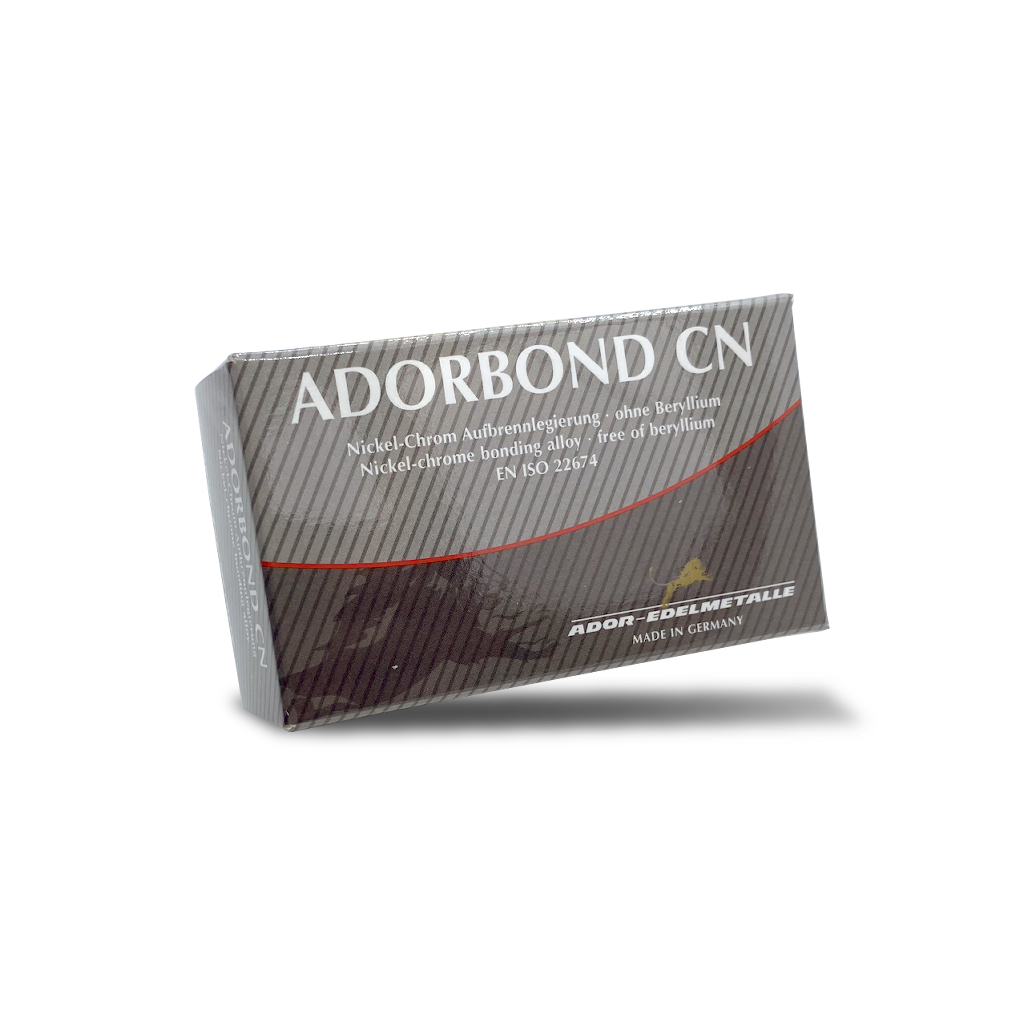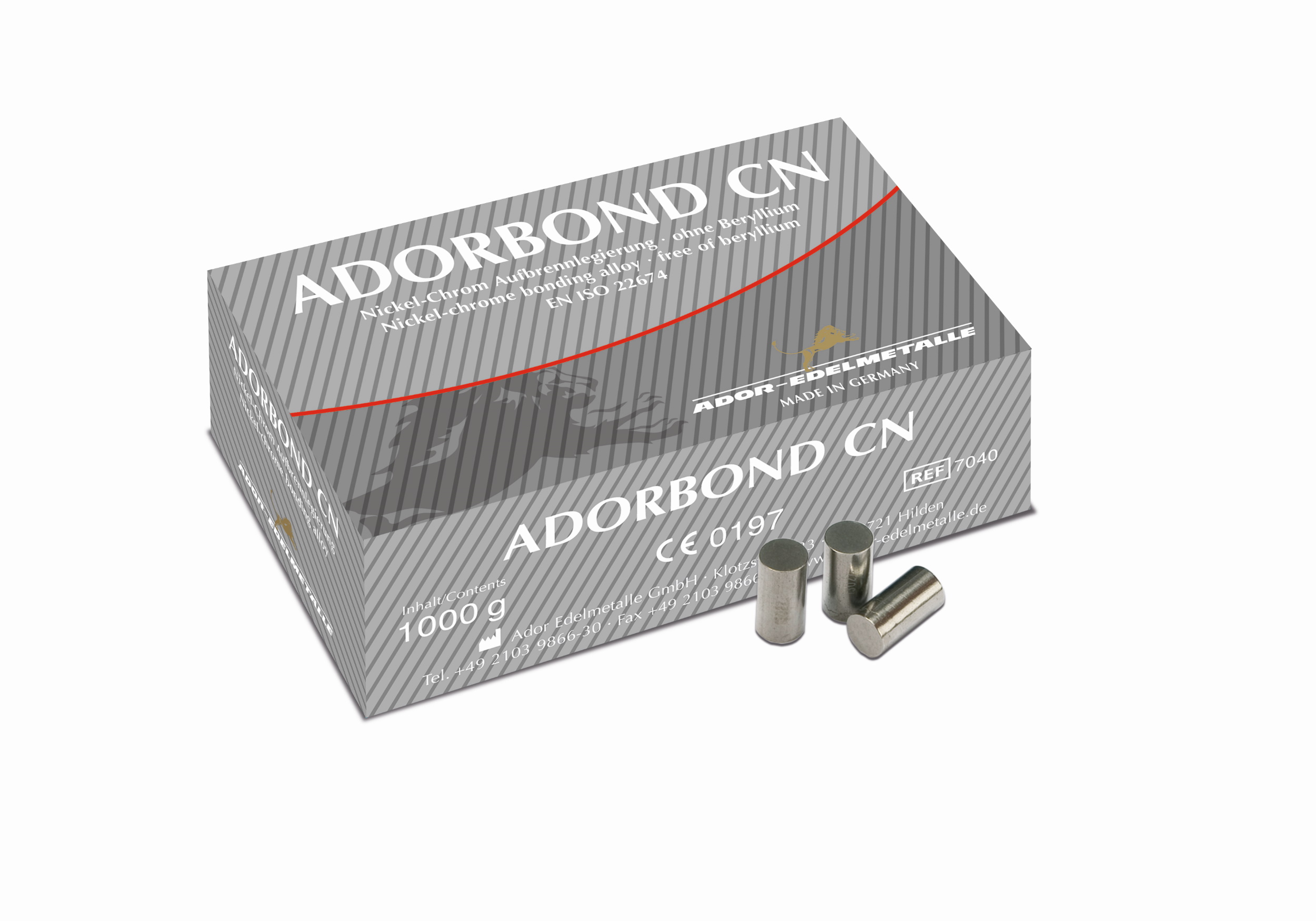ADORBOND CN
1000g
Nickel-chrome bonding alloy for high-melting ceramic compounds
199,90 € excl. VAT
| Title | Menge | Preis/Stück |
|---|---|---|
| NEM Aufbrennlegierungen | 5 - 9 | 5% 189,91 € |
| NEM Aufbrennlegierungen | 10 - 24 | 10% 179,91 € |
| NEM Aufbrennlegierungen | 25 - 49 | 15% 169,92 € |
| NEM Aufbrennlegierungen | 50 - 99 | 20% 159,92 € |
Description
Nickel-chrome bonding alloy for high-melting ceramic compounds
>> Instructions for use Download DE/EN
>> Instructions for use download EN/FR
ADORBOND® CN is a dental metal-ceramic alloy on the nickel basis ADORBOND® CN is free of cadmium, beryllium and lead and, according to EN ISO 22674, corresponds to type 3 for fixed multi-unit dentures.
| Composition wi | Technical specifications (normative index, condition cast/bond) | ||||||
| Ni | % | 62,7 | Density ϱ | g - cm-3 | 8,2 | ||
| Cr | % | 24,4 | Vickers hardness | HV 10 | 180 | ||
| Mo | % | 11,0 | Linear coefficient of thermal expansion α 25 - 500 °C | 10-6-K-1 | 13,9 | ||
| Si | % | 1,6 | |||||
| Nb, Mn, Fe | % | < 1 | Linear coefficient of thermal expansion α 20 – 600 °C | 10-6-K-1 | 14,0 | ||
| Melting interval TS - TL | °C | 1250-1340 | |||||
| Casting temperature TCast | °C | 1440 | |||||
| Highest recommended bonding temperature TBr,max | °C | 980 | |||||
| 0,2-% Yield strength Rp 0,2 | MPa | 330 | |||||
| Elastic modulus E | GPa | 205 | |||||
| Elongation at break A5 | % | 15 | |||||
| Processing recommendation | |||||||
| Modeling | |||||||
| Carry out wax-up as usual, but avoid wall thicknesses below 0.35 mm. Guide the casting channels indirectly. For the casting channels, use round wax wires with Ø 2-2.5 mm for single crowns and Ø 2.5-3 mm for bridges. For large jobs with 4 or more units, use distribution channels (cast bars) with Ø 3.5-4 mm, and up to Ø 5 mm for solid pontics. | |||||||
| Embedding and casting | |||||||
| Phosphate-bonded crown and bridge embedding compounds are suitable. The preheating temperature is 850-900 °C, holding time at the final temperature is min. 30 minutes. Follow the manufacture’s operating instructions for the casting machine. Always use a separate ceramic crucible for ADORBOND® CN to avoid contamination by other alloys. Clean crucible after each casting. Do not overheat the alloy. Casting can be started after all cylinders are completely melted and the melt becomes uniformly bright. Always melt with the flame in the reducing zone with circular movements above of the burner. Allow muffle to cool down to hand temperature and bed out without hitting the cone. | |||||||
| Ceramic firing | |||||||
| The commercially available normal-fusing bonding ceramics for non-precious bonding alloys with a suitable coefficient of thermal expansion (CTE) can be used. Please observe the corresponding working instructions and the information provided by the ceramic manufacturer regarding the cooling rate after firing.
After bedding out: 1. Separate channels and do the finishing work. Carbide cutters are recommended for this. Blast the framework surface in the stylus blaster with aluminum oxide 100 µm or 250 µm. 3. Clean the framework either with distilled water in an ultrasonic cleaner or with degreasing agent ethyl acetate. 4. Oxide firing (optional for checking the surface) should be about 5 min at approx. 960 °C under vacuum. Always sandblast the oxide layer again after firing and degrease. Note: cleanliness of the surface is the best protection against bubbles in the ceramic. 5. Apply a thin layer of Washbrand, fire only the second base coat for an even coverage. Always let paste opaque dry for 5-10 minutes at 600°C before heating. 6. Ceramic firing and cooling according to the manufacturer’s instructions. 7. In case a long-term cooling is necessary, carry out a cooling phase to approx. 750 °C after each dentine, correction and glaze firing. |
|||||||
| Finishing up
After firing the ceramic, rubberize unveneered framework parts and polish to a high gloss with a polishing paste for dental alloys or with rotating polishing tools. |
|||||||
| Soldering and welding
Soldering before firing with the ADORBOND® CC Lot and high-temperature flux. The width of the solder gap should be 0.05-0.2 mm. Laser welding with the ADORBOND® CC laser wire. |
|||||||
| Safety instructions
Metal dust is harmful to your health. Use suction when handling the powder, by finishing works and blasting. Hypersensitivity to the alloy components should be taken into account. In case of suspected intolerance with certain alloy components, the product should not be used. Product contains nickel! |
|||||||
| Warranty
These technical application recommendations are based on our own tests and experience and can therefore only be regarded as guidelines. The dentist or dental assistent himself is responsible for the correct application of the product. |
|||||||
Additional information
| Weight | 1048 g |
|---|---|
| Size | 1 kg, 100 g, 250 g, 500 g |
Only logged in customers who have purchased this product may leave a review.


Reviews
There are no reviews yet.